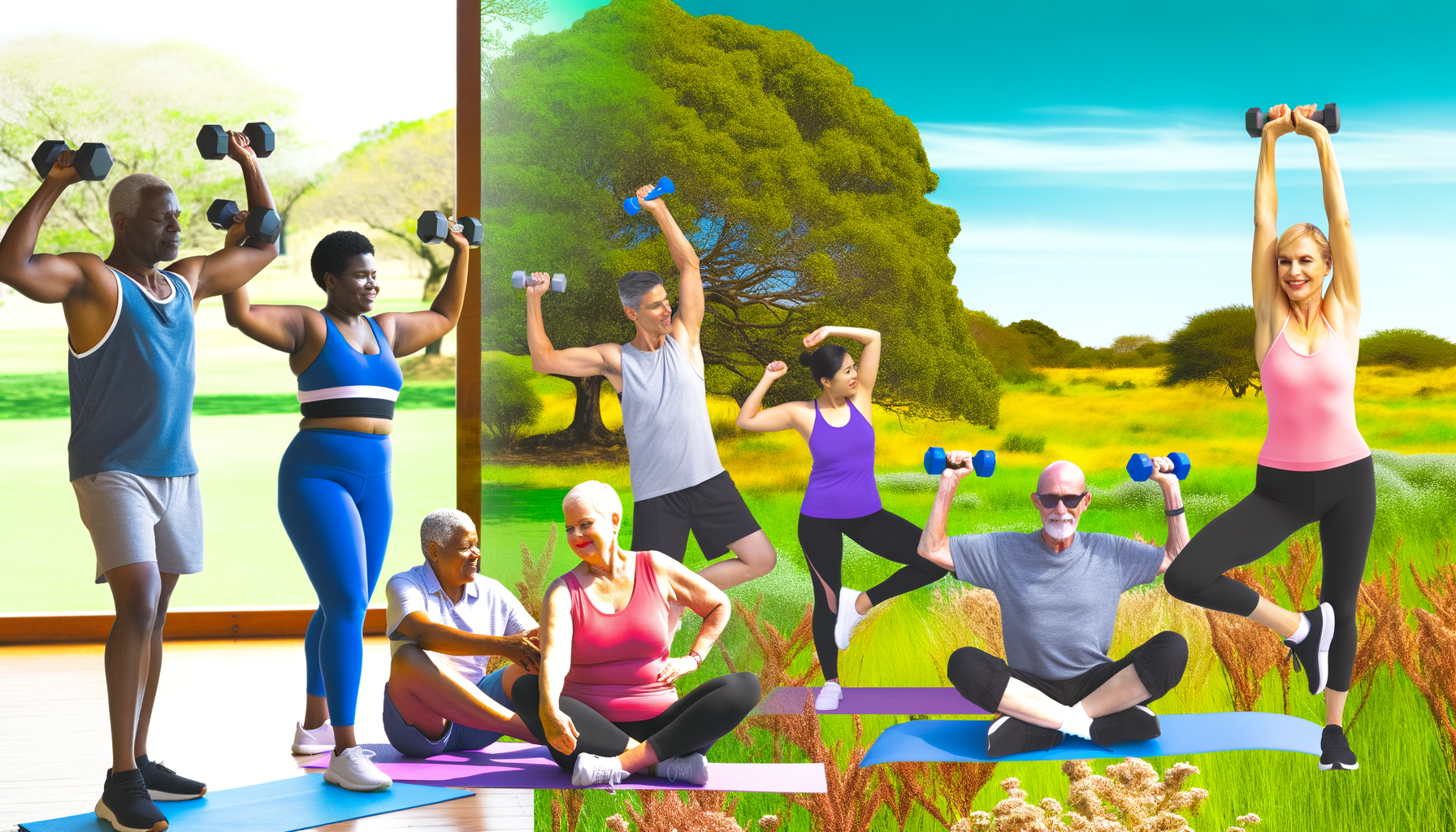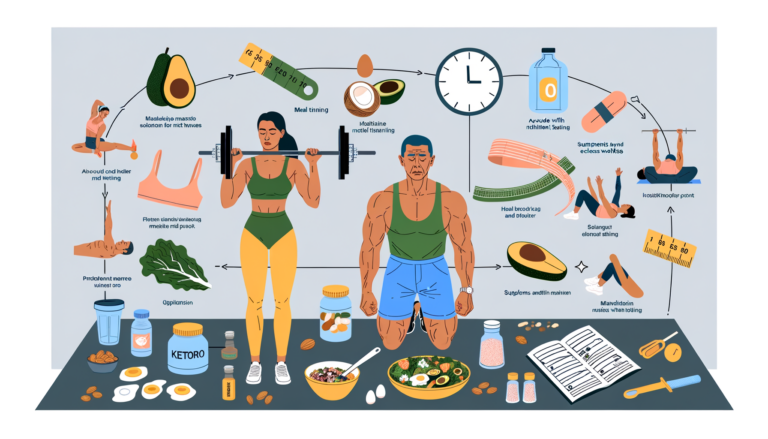Staying fit over 40 is crucial for maintaining strength, flexibility, and overall health, especially when following a ketogenic diet. In this guide, “Keto-Friendly Exercises for People Over 40,” we’ll explore the best workouts to complement your keto lifestyle. These exercises are designed to build muscle, improve flexibility, and enhance fat-burning, helping you get the most out of your keto journey while staying active and strong as you age.
Benefits of Low-Impact Cardio Workouts
Low-impact cardio workouts offer a gentler alternative to high-impact exercises like running or jumping. These workouts are beneficial for individuals with joint issues or those recovering from injuries. By engaging in low-impact cardio activities such as cycling, swimming, or using an elliptical machine, individuals can still reap the cardiovascular benefits without putting excessive strain on their joints.
Moreover, low-impact cardio workouts can be a suitable option for beginners who are looking to ease into a fitness routine. These exercises help improve cardiovascular endurance, strengthen the heart, and burn calories effectively. Additionally, low-impact cardio workouts can be customized to suit different fitness levels and goals, making them accessible to a wide range of individuals seeking to improve their overall health and well-being.
Importance of Incorporating Resistance Training
Resistance training is a crucial component of any well-rounded fitness routine. By engaging in exercises that target various muscle groups using external resistance, such as weights or resistance bands, individuals can enhance their strength, muscle tone, and overall physical performance. Additionally, resistance training plays a key role in improving bone density, which is especially important for reducing the risk of osteoporosis, a condition characterized by weakened and brittle bones.
Incorporating resistance training into a workout regimen not only helps individuals build lean muscle mass but also boosts their metabolism, leading to increased calorie burn at rest. This can be particularly beneficial for individuals looking to manage their weight or achieve fat loss goals. Furthermore, resistance training has been shown to have positive effects on mental well-being by reducing symptoms of anxiety and depression, enhancing self-esteem, and improving overall cognitive function.
Tips for Improving Flexibility Through Stretching
One effective technique to enhance flexibility is by incorporating dynamic stretching into your routine. Dynamic stretches involve moving parts of your body through a full range of motion in a controlled manner, helping to warm up muscles and increase flexibility before a workout. For example, leg swings or arm circles are dynamic stretches that can be beneficial in preparing your body for physical activity.
Another valuable tip for boosting flexibility is to practice static stretching at the end of your workout or during a dedicated stretching session. Static stretches involve holding a position for a prolonged period, allowing muscles to relax and lengthen. Engaging in static stretches for major muscle groups such as hamstrings, quadriceps, and shoulders can contribute to improved flexibility over time. Remember to breathe deeply and avoid bouncing during static stretches to prevent injury and promote optimal muscle elongation.
Effective Bodyweight Exercises for Strength
Bodyweight exercises are a practical and efficient way to build strength without the need for equipment. Incorporating exercises like push-ups, squats, and lunges into your routine can target multiple muscle groups simultaneously, helping to improve overall strength and endurance. These exercises use your own body weight as resistance, making them versatile and accessible for individuals of all fitness levels.
Another effective bodyweight exercise for strength is the plank. Holding a plank position engages the core, arms, and legs, helping to improve stability and overall body strength. Variations such as side planks or plank with leg lifts can add intensity and challenge different muscle groups. Incorporating these exercises into your workout routine can help you build strength, improve muscle tone, and enhance your overall fitness level.
The Role of Proper Nutrition in Fitness Goals
Proper nutrition plays a crucial role in achieving fitness goals. Your body requires essential nutrients such as proteins, carbohydrates, fats, vitamins, and minerals to support various physiological functions and maintain overall health. When you fuel your body with the right balance of nutrients, you can enhance your energy levels, improve muscle recovery, and support optimal performance during workouts.
>>> Check this post to learn how to overcome plateaus
In addition to fueling your body for exercise, proper nutrition also contributes to weight management and body composition. By consuming a well-rounded diet rich in whole foods such as fruits, vegetables, lean proteins, and whole grains, you can better regulate your calorie intake and support your fitness goals. Furthermore, staying hydrated and consuming adequate amounts of water is essential for proper digestion, nutrient absorption, and overall well-being.
How to Safely Increase Intensity in Workouts
To gradually enhance the intensity of your workouts, consider implementing progressive overload. This method involves gradually increasing the weight, reps, or duration of your exercises to continuously challenge your body. By systematically pushing your limits, you can effectively build strength and endurance over time. Pay attention to your body’s signals and progress at a pace that feels challenging yet manageable to avoid overexertion and reduce the risk of injury.
Another way to safely boost the intensity of your workouts is by incorporating interval training. This technique alternates between periods of high-intensity activity and lower-intensity recovery. Interval training can help elevate your heart rate, improve cardiovascular fitness, and burn more calories in a shorter amount of time. Start by incorporating short bursts of high intensity into your routine, gradually increasing the duration and intensity as your fitness level improves.
Benefits of Adding Yoga or Pilates to Routine
Yoga and Pilates are exceptional practices that can significantly contribute to overall physical and mental well-being. Incorporating these disciplines into your routine can enhance flexibility, strength, and balance. The deliberate movements and focus on breathing in yoga help to improve mindfulness and reduce stress levels. Similarly, Pilates emphasizes core strength and proper body alignment, which can aid in preventing injury and promoting better posture.
Moreover, both yoga and Pilates are adaptable to various fitness levels and can be modified to suit individual needs. By regularly engaging in these practices, you may experience increased energy levels, improved circulation, and a heightened sense of relaxation. The meditative aspect of yoga and the precise, controlled movements in Pilates offer not only physical benefits but also a mental respite from daily stressors.
The Importance of Rest and Recovery for Over 40s
Rest and recovery are vital components of any fitness routine, particularly for individuals over 40. As we age, our bodies may take longer to recover from intense workouts due to decreased muscle mass and slower repair processes. This age group needs to allow ample time for rest between workouts to prevent overtraining and reduce the risk of injury. Incorporating rest days into the weekly exercise schedule is crucial for maintaining overall health and well-being. Moreover, proper rest supports the body’s ability to repair and rebuild muscles, aiding in strength and endurance development.
In addition to physical recovery, adequate rest plays a significant role in mental and emotional well-being for those over 40. Rest allows for the reduction of stress levels and improves sleep quality, both of which are crucial for overall health. Ensuring a good balance between exercise and rest helps in preventing burnout and fatigue, allowing individuals to stay consistent and motivated in their fitness journey. By prioritizing rest and recovery, individuals can optimize their performance, reduce the risk of injury, and promote long-term health as they age.
Incorporating Balance and Stability Exercises
Balance and stability exercises play a crucial role in enhancing overall fitness levels and reducing the risk of injuries. By incorporating exercises that challenge proprioception and core strength, individuals can improve their coordination and stability. These types of exercises can range from simple standing on one leg to more advanced movements utilizing stability balls or balance boards. Consistent practice of balance exercises can improve muscle control and joint stability, leading to better performance in daily activities and sports.
Additionally, including balance and stability exercises in a workout routine can help with posture correction and alignment. Engaging the core and stabilizing muscles through specific exercises can promote better body awareness and alignment, ultimately aiding in reducing back pain and improving overall posture. Incorporating these exercises not only builds strength in smaller, stabilizing muscles but also enhances neuromuscular coordination, contributing to improved balance and stability in various movements and activities.
Setting Realistic Goals and Tracking Progress
When embarking on a fitness journey, it is crucial to establish realistic goals that align with your capabilities and aspirations. By setting specific, measurable, achievable, relevant, and time-bound (SMART) objectives, you can track your progress effectively and stay motivated. Whether aiming to improve endurance, strength, flexibility, or overall well-being, having clear goals allows you to focus your efforts and make tangible strides toward your desired outcomes.
Tracking your progress is essential for staying accountable and adjusting your fitness regimen as needed. Whether through journaling, using fitness apps, or working with a personal trainer, monitoring aspects like workout frequency, intensity levels, and performance improvements can provide valuable insights into your journey. Celebrating small victories along the way can boost your confidence and drive, setting the stage for continued success in reaching your fitness goals.
Key Takeaways (Keto-Friendly Exercises):
- Low-impact cardio is a great option for improving cardiovascular health while being gentle on joints.
- Resistance training builds strength, boosts metabolism, and improves bone density, making it essential for those over 40.
- Stretching and flexibility exercises, like dynamic and static stretching, are crucial for mobility and preventing injury.
- Bodyweight exercises offer an effective way to build strength without the need for equipment, focusing on functional fitness.
- Proper nutrition supports workout performance, recovery, and overall health.
- Rest and recovery are critical for maintaining long-term fitness, reducing injury risks, and ensuring mental and physical well-being.
- Balance and stability exercises help improve coordination and reduce injury risk, enhancing everyday movement and posture.
- Setting realistic goals and tracking progress ensures a consistent, motivating fitness journey tailored to your needs.







